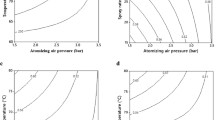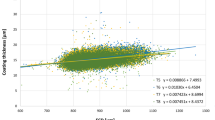Abstract
The aim of this study was to develop spheronized microparticulates as a drug delivery system using the 1-step closed rotor disk fluid-bed technology, and to scale up the batch spheronization process. Ibuprofen was used as the model drug and microcrystalline cellulose/sodium carboxymethyl cellulose hydrocolloid (Avicel® RC-581 or CL-611) was present as the diluent/binder. The mixture, in 1∶1 ratio, was blended with and without 1% sodium lauryl sulfate (SLS) and spheronized with the rotor disk insert, using either water or hydroxypropylmethyl cellulose (HPMC) as binder. Fluid-bed machines (Vector/Freund Flo-Coater model) FLM-1 (with 9-inch rotor insert for 0.75 kg) and FLM-15 (with a 12-inch and 19-inch rotor inserts for 1 kg and 5, 10 kg, respectively) were used. The critical process parameters included inlet air temperature, rotor disk speed and configuration, air flow, and rate of binder application. The 1 kg batch containing SLS that was made with 12-inch smooth stainless, steel or waffle teflon plates rotating at 500 rpm had desirable characteristics. The sphericity values were 0.88 and 0.91, with percent yield of 85.4 and 91.2 and drug content values of 94.47% and 91.44%, respectively. The spheroids showed good flow properties with respective rapid drug release (Q20=83.27 and 91.75). No difference was seen in the Avicel RC-581 and CL-611. Based on the 1 kg data, Avicel RC-581 and smooth stainless steel and waffle teflon plates (12 inch and 19 inch), the batch was scaled up to 5 and 10 kg. The scale-up parameters included rotor speed (124–300 rpm) and spray rate (90–140 g/min). The scale-up batches had similar flow characteristics, release rate, and size distribution. The geometric mean diameter increased as batch size increased, and slightly bigger spheroids were obtained using the waffle teflon plate. Ibuprofen spheres with very good physical characteristics were developed using the rotor disk fluid-bed technology, a 1-step closed process that did not require additional unit processes.
Similar content being viewed by others
References
Lindner H, Kleinebudde P. Use of powdered cellulose for the production of pellets by extrusion/spheronization. J Pharm Pharmacol. 1994;46:2–7.
Vervaet C, Baert L, Remon JP. Extrusion spheronisation: A literature review. Int J Pharm. 1995;116:131–146.
Sonaglio D, Bataille B, Ortigosa C, Jacob M. Factorial design in the feasibility of producing microcel MC 101 pelletes by extrusion/spheronization. Int J Pharm. 1995;115:53–60.
Parikh DM. Fluid-bed processing in the 1990s. Tabletting and Granulation Yearbook, Pharm Technol Suppl. October 1996.
Robinson RL, Hollenbeck RG. Manufacture of spherical acetaminophen pellets: comparison of rotary processing with multi-step extrusion and spheronization. Pharm Technol. 1991;15:48–56.
Rubino DP. Fluid-bed technology: Overview and criteria for process selection. Pharm Technol. June, 1999;23:104–113.
Korakianiti E, Rekkas DM, Dallas PP, Choulis NH. Development, production and in-vitro evaluation of enteric coated aspirin pellets.: The 18th Pharmaceutical Technology Conference and Exhibition, Proceedings, Vol. 2, April 13–16, Utrecht, The Netherlands.
Iyer RM, Augsburger LL, Parikh DM. Evaluation of drug layering and coating: effect of process mode and binder level. Drug Dev Ind Pharm. 1993;19:981–998.
Watano S, Sato Y, Miyanami K, Ito Y, Kamata T, Oda N. Scale-up of agitation fluidized bed granulation: III. Effects of powder feed weight and blade angle on granule size, shape and density. Chem Pharm Bull. 1995;43:1224–1226.
Block LH. Scale-up of disperse systems: theoretical and practical aspects. In: Lieberman HA, Rieger MM, Banker GS, eds. Pharmaceutical Dosage Forms: Disperse Systems. New York, NY: Marcel Dekker; 1998:363–394.
Mehta AM. Scale-up considerations in the fluid-bed process for controlled release products. Pharm Tech. 1988;12:46–54.
Newton JM, Chapman SR, Rowe RC. The assessment of scale-up performance of the extrusion/spheronization process. Int J Pharm. 1995;120:95–99.
Horsthuis GJB, van Laarhoven JAH, van Rooij RCBM, Vroorans H. Studies on upscaling parameters of the Gral high shear granulation process. Int J Pharm. 1993;92:143–150.
Adeyeye CM, Price JC. Chemical, dissolution stability and microscopic evaluation of suspensions of ibuprofen and sustained release ibuprofen-wax microspheres. J Microencapsulation. 1997;14:357–377.
Tsao JC, Savage TS. High-performance liquid chromatographic determination of ibuprofen in bulk drug and tablets. Drug Dev and Ind Pharm. 1985;5:1123–1131.
Law MFL, Deasy PB. Use of canonical and other analyses for the optimization of an extrusionspheronization process of indomethacin. Int J Pharm. 1997;146:1–9.
Eichler K. State-of-the-art of fluid bed processing. Farmacevtski Vestnik. 46(Oct Suppl): p 165. 1995
Newton JM, Chapman SR, Rowe RC. The influence of process variables on the preparation and properties of spherical granules by the process of extrusion and spheronisation. Int J Pharm. 1995;120:101–109.
Watano S, Sato Y, Miyanami K, Ito Y, Kamata T, Oda N. Scale-up of agitation fluidized bed granulation: I. Preliminary experimental approach for optimization of process variables. Chem Pharm Bull. 1995;43:1212–1216.
Schaefer T, Worts O. Control of fluidized bed granulation: III. Effects of inlet air temperature and liquid flow rate on granule size and size distribution. Control of moisture content of granules in the drying phase. Arch Pharm Chem Sci Ed. 1978;6:1–13.
Ormos Z, Pataki K, Csukas B. Granulation in a fluidized bed: II. Effects of the amount of the binder on the physical properties of granules formed in a fluidized bed. Hung J Ind Chem. 1973;1:307–328.
Gordon RE, Rosanske WT, Fonner DE, Anderson NR, Banker GS. Granulation technology and tablet characterization. In: Lieberman HA, Lachman L, Schwartz JB, eds. Pharmaceutical Dosage Forms: Tablets New York, NY: Marcel Dekker; 1990:245–348.
Watano S, Sato Y, Miyanami K, Murakami T, Nagami N, Ito Y, Kamata T, Oda N. Scale-up of agitation fluidized bed granulation: II. Effects of scale, air flow velocity and agitator rotational speed on granule size, size distribution, density and shape. Chem Pharm Bull. 1995;43:1217–1220.
Ghali ES, Klinger GH, Schwartz JB. Modified drug release from beads prepared with combinations of two grades of microcrystalline cellulose. Drug Dev Ind Pharm. 1989;15:1455–1473.
O'Connor RE, Schwartz JB. Spheronization: II. Drug release from drug-diluent mixtures. Drug Dev Ind Pharm. 1985;11:1837–1857.
Author information
Authors and Affiliations
Corresponding author
Additional information
Published: February 8, 2002.
Rights and permissions
About this article
Cite this article
Chukwumezie, B.N., Wojcik, M., Malak, P. et al. Feasibility studies in spheronization and scale-up of ibuprofen microparticulates using the rotor disk fluid-bed technology. AAPS PharmSciTech 3, 2 (2002). https://doi.org/10.1208/pt030102
Received:
Accepted:
DOI: https://doi.org/10.1208/pt030102




